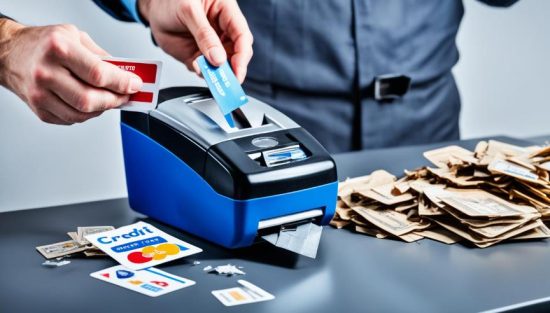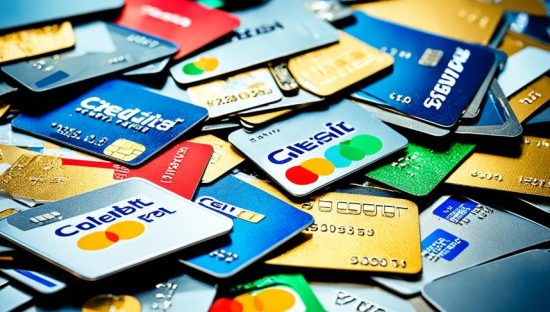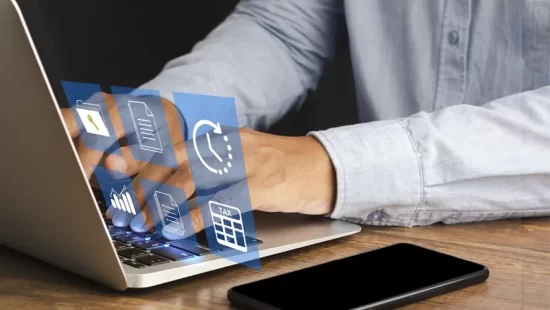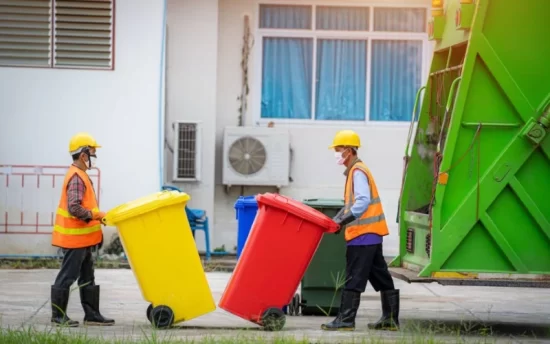
Did you know that over 18 billion credit cards were in circulation worldwide in 2020? With the growing popularity of credit cards, it’s becoming increasingly important to understand how to safely and securely dispose of old credit cards to protect your personal information and prevent unauthorized access.
Improper credit card disposal can put you at risk of identity theft and contribute to environmental hazards. In this blog, we will take you through the steps of safely disposing of your old credit cards, from deactivating them to environmentally-friendly options for disposal. By the end, you’ll have the knowledge and tools to ensure that your credit cards are disposed of in a way that safeguards your identity and minimizes your environmental impact.
Risks of Improper Credit Card Disposal
Properly disposing of your old credit cards is crucial to protect yourself from various risks. Improper disposal can potentially expose you to identity theft and pose environmental hazards. In this section, we will delve into these risks and their potential consequences.

Identity Theft Concerns
Improperly discarded credit cards can become a goldmine for identity thieves. These criminals can retrieve personal information from discarded cards, including your name, account number, expiration date, and even the three-digit security code on the back. Armed with this information, they can engage in fraudulent activities, such as making unauthorized purchases or opening new accounts under your name. Falling victim to identity theft can have serious financial and emotional consequences, making it crucial to dispose of your credit cards securely.
Environmental Hazards of Plastic Cards
Another significant risk of improper credit card disposal lies in the environmental impact of plastic cards. Most credit cards are made of PVC (polyvinyl chloride), a type of plastic that is not biodegradable. When plastic cards are not disposed of properly, they can end up in landfills or bodies of water, contributing to pollution and harming ecosystems. Properly disposing of your credit cards by choosing eco-friendly options, such as recycling, helps mitigate these environmental hazards.
Preparing Your Credit Cards for Safe Disposal
Before disposing of your credit cards, it is crucial to take certain steps to ensure that they are prepared for safe disposal. These precautions will help protect your personal information and prevent unauthorized use. Here are some guidelines to follow:
- Remove Personal Information: Start by removing any personal information from your credit card. This includes peeling off any stickers or labels that may have your name, account number, or other sensitive details. Use a permanent marker to black out any remaining printed information on the card.
- Block the Magnetic Strip: To ensure that the magnetic strip on your credit card cannot be read or used, you can use a strong magnet to demagnetize it. Simply swipe the magnet across the magnetic strip several times to render it unreadable.
- Destroy the Chip: If your credit card has a chip, you should physically destroy it to prevent any potential misuse. You can do this by cutting into the chip with scissors or bending it until it breaks.
- Securely Store or Destroy: Once you have prepared your credit card for disposal, you can either securely store it in a safe location or proceed with proper disposal methods.
How to Dispose of Old Credit Cards Steps

To ensure the safe disposal of your old credit cards, it is important to follow a series of steps that will protect your personal information and prevent unauthorized use. By deactivating your card, physically destroying it, and practicing secure trash disposal, you can confidently dispose of your old credit cards without worrying about identity theft or other risks. Follow these steps to properly dispose of your old credit cards:
Deactivate Your Card
The first step in disposing of your old credit card is to deactivate it. Contact your credit card issuer or bank and inform them that you would like to close or deactivate the card. By deactivating the card, you ensure that it can no longer be used for any transactions. It is essential to deactivate your card to prevent any unauthorized charges or fraudulent activities.
Physical Destruction: Cutting and Shredding
After deactivating your card, it is crucial to physically destroy it to ensure that the card cannot be used or reconstructed. One effective method is to cut the card into small pieces using scissors or a pair of shears. Make sure to cut through the chip, magnetic strip, and signature area. Alternatively, you can use a shredder specifically designed for credit cards. Shredding the card into tiny pieces adds an extra layer of security, making it virtually impossible to retrieve any sensitive information.
Secure Trash Disposal Practices
Once you have completely destroyed your old credit card, it is essential to dispose of the remnants securely. Never throw the shredded pieces or cut-up card into your regular trash bin. Instead, place them in a separate bag or container, preferably one that is not transparent. Mix the shredded pieces with other non-sensitive waste to further reduce the chances of someone reconstructing the card.
Always be cautious when discarding your old credit cards and follow these steps to ensure their secure disposal. By deactivating your card, physically destroying it, and using secure trash disposal practices, you can protect your personal information and minimize the risk of identity theft.
Alternative Methods: Recycling Your Old Credit Cards
Recycling is an eco-friendly option for disposing of old credit cards. Instead of tossing them in the trash, consider recycling them to minimize waste and contribute to a cleaner environment. There are recycling facilities that accept plastic cards and ensure they are properly recycled. To recycle your old credit cards, start by researching local recycling centers or drop-off locations that accept plastic cards. Many recycling facilities have dedicated bins specifically for plastic cards, making it convenient to recycle them. Look for facilities that follow environmentally-friendly practices and prioritize responsible waste management.
Recycling your old credit cards not only helps reduce the amount of plastic waste in landfills but also conserves valuable resources. Plastic cards can be repurposed or transformed into new products through the recycling process, reducing the need for virgin materials.
Using a Professional Shredding Service
Using a professional shredding service ensures secure disposal of old credit cards, protecting personal information from theft. Look for certified providers like NAID AAA to ensure compliance with industry standards. Shredding ensures cards are completely destroyed and materials are recycled, offering a convenient and environmentally friendly solution.
Protecting Your Information During Disposal

Safeguarding your personal information during the credit card disposal process is crucial. Taking proactive measures to protect your information can help prevent identity theft and keep your sensitive data secure.
Here are some practical tips to ensure your information stays safe:
- Obfuscate Sensitive Details: Before disposing of your credit card, use a black marker to obscure sensitive information such as the card number, expiration date, and CVV code. This will make it more difficult for identity thieves to use your discarded card for fraudulent purposes.
- Minimize Data Exposure: When destroying your credit card, take care to minimize the exposure of your personal data. Avoid cutting or shredding the card in public spaces where others may have access to your information. Instead, choose a secure and private location to dispose of your card.
- Secure Disposal Methods: Consider using a cross-cut shredder or scissors to physically destroy your credit card. By rendering the card unreadable, you can prevent anyone from retrieving your information from the discarded pieces.
- Separate Disposal: To further protect your information, separate the shredded or cut-up card into different trash bags or bins. This makes it more challenging for identity thieves to reconstruct the card and obtain your sensitive data.
- Monitor Your Accounts: After disposing of your credit card, closely monitor your financial accounts for any suspicious activity. Regularly review your credit card statements and credit reports to ensure there are no unauthorized charges or accounts opened in your name.
Eco-Friendly Disposal Options
There are eco-friendly options beyond recycling for old credit cards, such as upcycling into new products like jewelry or coasters, which contribute to a circular economy by reducing new material consumption. Donating them to community centers for arts and crafts also promotes sustainable practices and supports local creative initiatives, encouraging conversations about sustainability and giving old credit cards a renewed purpose in minimizing environmental impact.
When to Destroy Your Credit Card: Timing Considerations
Properly timing the disposal of your credit cards is crucial to maintain financial security and ensure a seamless transition to a new card. By considering a few key factors, you can effectively determine when the right time is to destroy your credit cards.
1. Expiration Date: The expiration date of your credit card can serve as a useful indicator for when to destroy it. As the expiration date approaches, it’s advisable to start the process of obtaining a new card and planning for secure disposal.
2. Replacement Card Issuance: If your credit card company has issued a replacement card, it’s a clear sign that the current card should be destroyed. Once you receive the new card, promptly deactivate and dispose of the old one to prevent any potential unauthorized use.
3. Pending Transactions and Automatic Payments: Before destroying your credit card, it’s important to review your recent transactions and confirm that there are no pending charges or automatic payments linked to the card. It’s recommended to wait until all transactions have cleared before proceeding with disposal.
4. Secure Alternative Payment Methods: As you approach the timing for credit card disposal, ensure that you have alternative payment methods in place to avoid any inconvenience. This may include activating your new credit card, setting up mobile payment options, or exploring other types of payment solutions.
Creative Uses for Expired Credit Cards
Expired credit cards don’t have to end up in the trash! There are plenty of creative and practical ways you can repurpose these old cards. Instead of letting them go to waste, why not give them a new life through arts and crafts projects or by finding unique household applications? Let’s explore some creative uses for expired credit cards that will inspire you to get crafty and resourceful.
Arts and Crafts Projects
One of the most popular ways to repurpose expired credit cards is through arts and crafts projects. These versatile pieces of plastic can be transformed into stunning works of art or used as tools for various crafting techniques. Here are a few ideas to get you started:
- Create unique mixed media collages by cutting up expired credit cards and incorporating them into your artwork.
- Make personalized jewelry pieces such as earrings or pendants by cutting and shaping the cards into desired shapes.
- Use them as stencils for painting or adding texture to your artwork.
These are just a few examples to spark your creativity. The possibilities are endless when it comes to using expired credit cards in your arts and crafts projects. With a little imagination, you can turn these mundane items into captivating pieces of art.
Practical Home Solutions
Aside from arts and crafts, repurposed credit cards can also be handy in various practical home solutions. Here are a few practical uses for expired credit cards:
- Use them as guitar picks or as tools for playing other stringed instruments.
- Turn your old credit cards into earbud holders by cutting slits into them and wrapping the earbud cords around.
- Create custom plant markers for your garden by labeling them with the names of your favorite plants.
Digital Security Measures After Physical Disposal
Properly disposing of your old credit cards is an essential step in protecting your personal information. However, it’s important to remember that digital security is equally crucial in the post-credit card disposal phase. Taking specific measures to safeguard your online presence can help prevent unauthorized access, identity theft, and potential fraud attempts.
One of the first digital security measures to implement is updating your passwords. After disposing of your old credit cards, change the passwords for all your financial accounts, including banking and credit card accounts. Create strong, unique passwords that combine letters, numbers, and symbols, and avoid using easily guessable information, such as your name or birthdate. Regularly updating these passwords adds an extra layer of security to your financial transactions.
Monitoring your accounts regularly is another crucial step. Keep a close eye on your credit card statements, bank transactions, and other financial records to ensure there are no unauthorized or suspicious activities. Report any suspicious transactions to your financial institution immediately. By staying vigilant, you can detect and address any potential fraudulent activity promptly, minimizing the risk of financial loss.
FAQs on Disposing Old Credit Card
Can I recycle my old credit cards?
Yes, recycling is an eco-friendly option for credit card disposal. Look for recycling facilities that accept plastic cards to minimize waste and conserve resources.
How can I protect my information during credit card disposal?
To protect your information, use a black marker to obscure sensitive details and minimize the exposure of your personal data during the disposal process.
When is the best time to destroy my credit card?
Consider factors such as the expiration date, replacement card issuance, and any pending transactions or automatic payments when determining the timing for credit card disposal.








